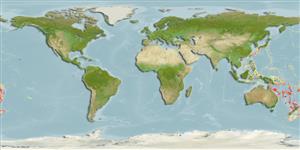Parvamussium retiaculum Dijkstra, 1995
| Native range | All suitable habitat | Point map | Year 2050 |

|
| This map was computer-generated and has not yet been reviewed. |
| Parvamussium retiaculum AquaMaps Data sources: GBIF OBIS |
Envoyez vos Photos
Images Google | No image available for this species;
drawing shows typical species in Propeamussiidae.
Images Google | No image available for this species;
drawing shows typical species in Propeamussiidae.
Classification / Names Common names | Synonyms | CoL | ITIS | WoRMS
| Pectinida | Propeamussiidae
Environment: milieu / climate zone / depth range / distribution range Écologie
; profondeur 512 - 797 m (Ref. 89006). Temperate
Distribution Pays | Zones FAO | Écosystèmes | Occurrences | Introductions
Southwest Pacific: Kermadec and Norfolk islands, and New Caledonia.
Length at first maturity / Taille / Poids / Âge
Maturity: Lm ? range ? - ? cm
Maximum depth from Ref. 101153. Living at 680 m to 700 m water depth (Ref. 89006).
Life cycle and mating behavior Maturité | Reproduction | Frai | Œufs | Fécondité | Larves
Members of the class Bivalvia are mostly gonochoric, some are protandric hermaphrodites. Life cycle: Embryos develop into free-swimming trocophore larvae, succeeded by the bivalve veliger, resembling a miniature clam.
Référence principale
Références | Coordinateur | Collaborateurs
Spurgeon, A. 2007. (Ref. 8121)
Statut dans la liste rouge de l'IUCN (Ref. 130435)
statut CITES (Ref. 108899)
Not Evaluated
CMS (Ref. 116361)
Not Evaluated
Menace pour l'homme
Utilisations par l'homme
| FishSource |
Outils
Plus d'informations
Pays
Zones FAO
Écosystèmes
Occurrences
Introductions
Stocks
Écologie
Régime alimentaire
Éléments du régime alimentaire
Zones FAO
Écosystèmes
Occurrences
Introductions
Stocks
Écologie
Régime alimentaire
Éléments du régime alimentaire
Taille/Âge
Croissance
Longueur-poids
Longueur-longueur
Morphologie
Larves
Abondance
Croissance
Longueur-poids
Longueur-longueur
Morphologie
Larves
Abondance
Sources Internet
BHL | BOLD Systems | CISTI | DiscoverLife | FAO(Publication : search) | Fishipedia | GenBank (genome, nucleotide) | GloBI | Gomexsi | Google Books | Google Scholar | Google | PubMed | Arbre de Vie | Wikipedia (Go, chercher) | Zoological Record
Estimates based on models
Preferred temperature
(Ref. 115969): 2 - 4.7, mean 3 (based on 306 cells).



